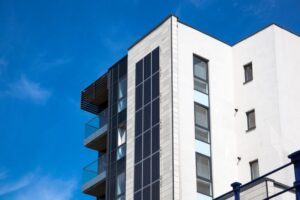Who pays for fire safety remedies in residential blocks? Examining the cases so far
The Building Safety Act provides for leaseholders to be protected from having to pay for remediation of fire safety defects in their blocks, but who is ultimately going to foot the bill? Ron Alalouff examines a number of cases which may point the way.
In what is believed to be the first contested case for a remediation order under the Building Safety Act, leaseholders in two residential blocks in Streatham, south west London, successfully applied for the replacement of unsafe external cladding and the rectification of other defects at their landlord’s expense.
 One of the blocks at 2-4 Leigham Court Road had been converted from an office development in 2005, with two storeys added making it six storeys high, while the other is a seven-storey new build separated from the existing block by a party wall.
One of the blocks at 2-4 Leigham Court Road had been converted from an office development in 2005, with two storeys added making it six storeys high, while the other is a seven-storey new build separated from the existing block by a party wall.
Following the Grenfell Tower fire, there were concerns about the aluminium cladding on the top two storeys of each block and firestopping of internal compartments.
An inspection report in June 2001 found that:
- There were limited horizontal and an absence of vertical cavity barriers
- The insulation – while compliant at the time of construction – was now non-compliant
- There was no firestopping around vents within cavities
- The vents used were not fire-rated, and
- Combustible materials had been used as part of the external wall system
- The tribunal in the case of Waite & others v Kedai Ltd made an order for remediation, setting a deadline of September 2025 for the work to be completed.
In what may come to be viewed as a precedent, the tribunal held that although the Building Safety Act did not specify the standard to which any remediation work should be made, it should be compliant with building regulations at the time of remediation and – at the very least – allow for a satisfactory EWS1 form to be issued.
In an interesting twist, however, a new building survey carried out during the preparation of the case established that the buildings are within scope to exceed 18m in height, whereas previously they were wrongly measured as below the 18m scope.
This new finding enables the freeholder to apply for funding from the Government’s Building Safety Fund.
Uncontested tribunal case
An earlier case concerned a group of 18 leaseholders who won almost £195,000 from the developer/freeholder of their building for the replacement of combustible balconies.
 Although the case – which was heard in January 2023 – was eventually not contested by the developer, Inspired Sutton Ltd, the tribunal ruled that the leaseholders were able to obtain a remediation contribution order under s.124 of the Building Safety Act.
Although the case – which was heard in January 2023 – was eventually not contested by the developer, Inspired Sutton Ltd, the tribunal ruled that the leaseholders were able to obtain a remediation contribution order under s.124 of the Building Safety Act.
While these are the first cases of successful remediation orders made under the Building Safety Act, there are a number of claims pending for remediation.
One of these, according to a report in the Financial Times, is at the former Olympic Park in east London. Triathlon Homes has applied for a remediation contribution order under the Building Safety Act to require the freeholder of the site – Get Living – to accept responsibility for around £16 million of work on the homes Triathlon manages.
Reported defects such as missing fire breaks and the presence of ACM cladding have been identified at the properties.
Triathlon claims it shouldn’t have to pay for the remediation, as it leases the properties from Get Living. Get Living – which has set aside £14.3 million for fire safety remediation works at East Village properties it doesn’t own – claims that Triathlon is not willing to pay its share of the costs.
Get Living is also the majority shareholder in EVML, the management company responsible for maintaining common parts of the estate, including fire safety.
EVML has applied for £13.5 million from the government’s Building Safety Fund to cover most of the remediation costs of Triathlon-managed properties.
Prosecution under Housing Act 2004
 In a related case, Newham Council has successfully prosecuted the owner of a nine-storey block in Forest Gate, also in East London.
In a related case, Newham Council has successfully prosecuted the owner of a nine-storey block in Forest Gate, also in East London.
The council prosecuted Chaplair Ltd under the Housing Act 2004 after it failed to remove cladding on the Lumiere building under and improvement notice served in September 2020.
Though work to remove the dangerous cladding eventually began in May 2021 and was completed by February 2022, the council successfully argued at City of London Magistrates Court that there was no reasonable excuse for the delay.
As more cases emerge and come before the tribunal, we will have a clearer picture of who is ultimately going to have to pay for remediation of serious fire safety defects in residential blocks, and to what extent leaseholders are shielded from those costs.
This article was first published on SHP’s sister site for fire and security news, IFSEC Insider.
Who pays for fire safety remedies in residential blocks? Examining the cases so far
The Building Safety Act provides for leaseholders to be protected from having to pay for remediation of fire safety defects in their blocks, but who is ultimately going to foot the bill?
Ron Alalouff
SHP - Health and Safety News, Legislation, PPE, CPD and Resources Related Topics
Hundreds of workplace buildings to be inspected for safety this week
Graham Watts OBE appointed Chair of BSCF
Legal insight: Common errors in fire safety

 One of the blocks at
One of the blocks at  Although the case – which was heard in January 2023 – was eventually not contested by the developer, Inspired Sutton Ltd, the tribunal ruled that the leaseholders were able to obtain a remediation contribution order under s.124 of the Building Safety Act.
Although the case – which was heard in January 2023 – was eventually not contested by the developer, Inspired Sutton Ltd, the tribunal ruled that the leaseholders were able to obtain a remediation contribution order under s.124 of the Building Safety Act. In a related case,
In a related case,